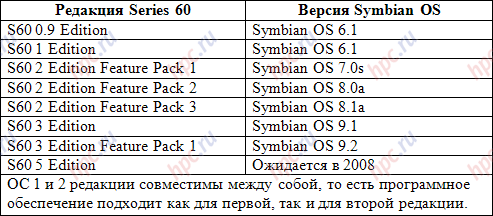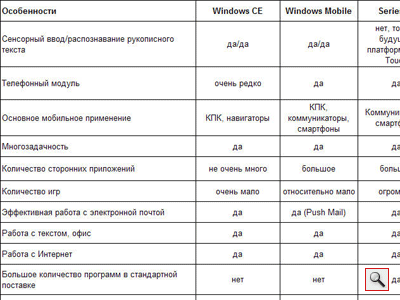Nowadays it is difficult to imagine anyone that avoids a mobile phone or music player. Flight of the scientific and technical ideas spawned a variety of devices for work and entertainment. One of the most common devices of this kind was the mobile phone, now overgrown with so many features, the phone began to call the new buzzword "gadget". However, devices from different manufacturers have a different functionality, some functionality you need is one device, some - in another. In this confusion comes to the rescue universal mobile computer. What is it? The answer can be found in our new articles on the mobile multi-function computers. Today we offer you to familiarize with the general principles for constructing smart handheld devices, and we decided to start from scratch - operating systems. The fact that it is, you know, after reading the first part, called "Mobile operating system."
Pocket assistant - who is he?
We began the article with an ulterior motive to mention cell phones. Today, many quite functional, more or less advanced the tube, but the market is also well represented, and handheld computers (PDAs) and smartphones, and communicators, and specific device - navigators. So what are all these devices? Of course, the tube or the player (even advanced) - is a thing in itself, such devices are designed for any particular purpose and objectives, and all the capabilities of these devices is strictly nastrogo built into the firmware, but to add something new to most change the device to the one that has the desired function. The unilateral lack PDA, communicators and smartphones. This was made possible thanks to the fact that we have constructed many models of these devices on a common platform, called the Operating System (OS), almost the same as the well-known desktop. As you probably guessed, the operating system makes it possible not only flexible configuration and installation programs, but also writing of any application to suit your needs, so called smart devices and smart - they can be almost anything that can be desktop or laptop. On the market today there are several best-known operating systems: the ubiquitous Microsoft family of Windows Mobile, Symbian, Palm, as well as some less common operating systems such as Mac OS X or Linux. Let us consider the peculiarities of each of these operating systems in detail.
Operating systems for mobile devices
The family of Windows Mobile
Most famous, Microsoft supplies the market with not only the operating system for home computers, and handheld computers, smartphones and communicators. Windows CE - a compact version of the operating system for handheld computers (Handheld PC) and embedded systems. This system is very similar to the desktop version of Windows, but has nothing to do with it. The main feature of this OS is the ability to work with a small amount of RAM (5 MB), as well as support for mobile processor architectures ARM, MIPS, Hitachi SuperH (mobile processors) and even x86 (desktop processors).
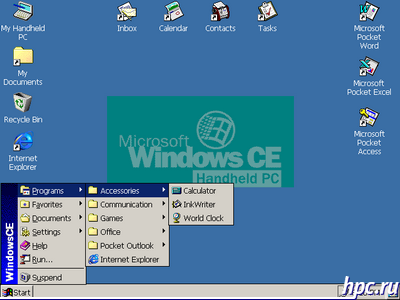 |
| Windows CE interface is very similar to the desktop version of Windows |
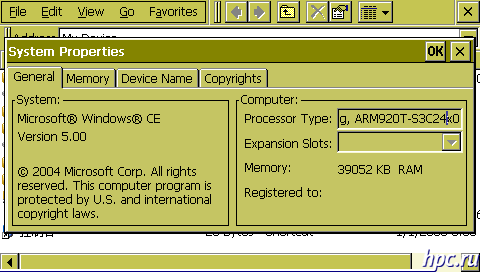 |
| Windows CE interface is very similar to the desktop version of Windows |
In olden days this operating system is used in handheld computers, which are functionally not far removed from the notebook, and now Windows CE is a key platform for the construction of car navigation that allows you to create multi-function devices with multi-media bias.The fact that Linux not only supports the installation of third-party software, but also has a multi-tasking, allowing the device to Windows CE have a very good set of features. Naturally, the support and touch screen. Several years ago, CCP made on this platform (Casio model from Cassiopeia), today interface Windows CE (fifth edition) can boast of automotive and handheld navigation devices, is especially famous among them models from Nokia, Mitac Mio, LG, Clarion, GlobalSat, Pocket Navigator and others. This multifunction device is extremely useful in the car, especially on long journeys to unfamiliar places - just will not get lost.
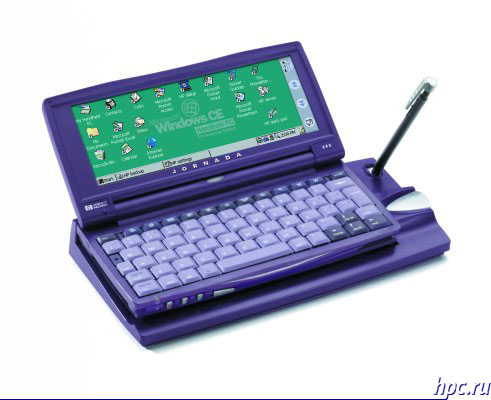 |
| In the olden days was used in Windows CE handheld computers. In the photo HP Jornada 680 |
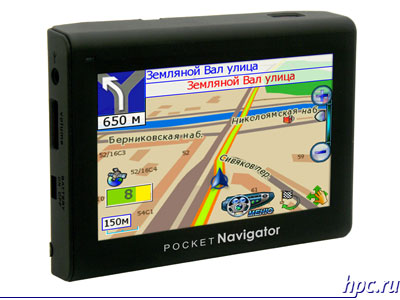 |
| Pocket Navigator PN-4300 operates on the Windows CE |
Thus, Windows CE - a specific OS with a fairly narrow range of applications and more often in the professional sphere. Windows Mobile - the further development of Windows CE. Common of these is the OS kernel, the interface is radically different, in addition, Windows Mobile supports core processor architecture ARM. Today the actual Windows Mobile (WM) version 6. WM 6 is divided into three groups, each to their device, so, Windows Mobile 6 Professional is designed for communicators and includes a module for making phone calls and touch screen support.
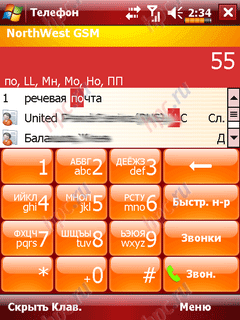 |
| Windows Mobile 6 Professional supports the telephone features and touchscreen |
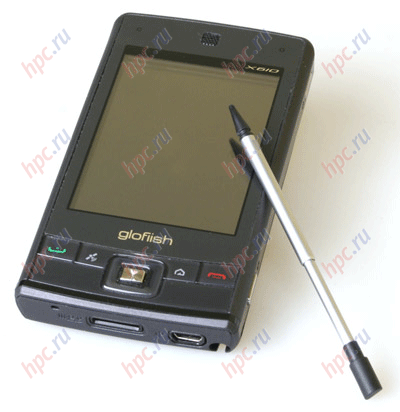 |
| Communicator glofiish X610, WM6 Professional operating system |
Windows Mobile 6 Standard lacks support for touch screen and is designed for smartphones.
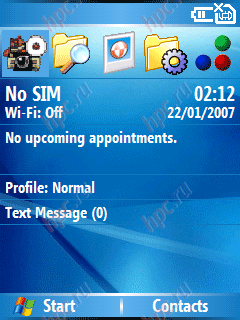 |
| Windows Mobile 6 Standard, phone functions without touchscreen |
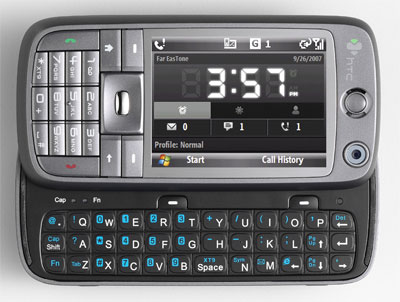 |
| Smartphone HTC S730, the operating system WM6 Standard |
Finally, WM 6 Classic does not have a phone module at all, but it has touch screen support, and as you might imagine, is designed for PDAs.
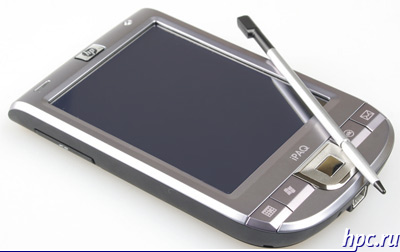 |
| HP iPAQ 114, operating system, WM6 Classic |
The main features of the OS family of Windows Mobile are: flexible adjustment of virtually all parameters, support for interface skins, installing third party software (players, games, navigation software, calculators, dictionaries, etc.) that significantly expands the capabilities of the device with WM. The operating system already contains many features - it's the messages (SMS, e-mail), media player, Internet Explorer, calendar, notes, address book - that is a standard phone and PDA functionality. By design reminiscent of a desktop operating system Windows, but have little to do with it, however, those who are accustomed to a home Windows will be psychologically nice to see familiar colors and logo. Strain WM, taken from Windows CE - the open architecture. This opens up unprecedented opportunities to install additional software, you can even replace and build on standard software WM. However, this feature makes the system less stable - the more established programs, the greater the likelihood of conflict. Of course, WM has a multitasking - that is, on such a device can run multiple programs and work with them (eg, listen to music, view photos and surf the Internet). Chronology of different versions of Windows Mobile is shown in the table.
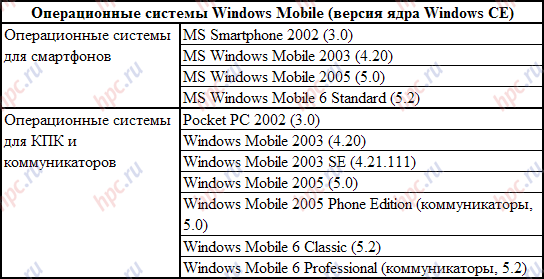 |
Setting WM - lesson quite fascinating, so many of you will find this operating system all that we need to configure - interface speed, add / remove functions, installing different drivers, software for networking, games and more. In general, Windows Mobile - Operating System for those who like to delve into the settings and find out for myself something new in technology, in short, is technically advanced person, but having spent a couple of weeks on the development machine, you'll be pleasantly surprised by its versatility and functionality , moreover, that all the tweaks available through the registry, as a home PC. Concerning software, we mention that for the WM represented a huge number of third-party software - business applications, alternative browsers, for ICQ, reading books, calculators, multi media players and more, for every taste, just a list of quality games is not so extensive - in fact WM was originally intended for business users, but those games that are available - a very attractive and well made. And, by the way, yet for Windows Mobile there are practically no viruses.
Family of operating systems, Palm OS - Mobile pioneers
Palm OS - one of the first mass of operating systems for handheld computers. Around the same time, the CCP have been called PDA - personal digital assistant. Palm OS appeared in 1996, but much earlier had invented the method of handwriting text lain based Palm OS. Palm OS-based manufactured mainly PDAs and Smartphones Treo. Treo smartphones are distinguished by QWERTY-keyboard and touch screen, of course, they have a modulus of calls that enhances their capabilities as PDAs. Of course, having a touch screen in the Treo allows you to rank them for communicators, but the company palmOne another opinion - that the company is positioning as the Treo smartphones, but the classification will be discussed in the next part of this article.
| Part I - The mobile operating system "width =" 260 "height =" 263 "/> |
| Palm OS Garnet 5.4 |
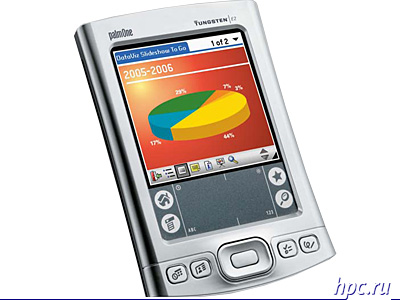 |
| palmOne Tungsten E2 |
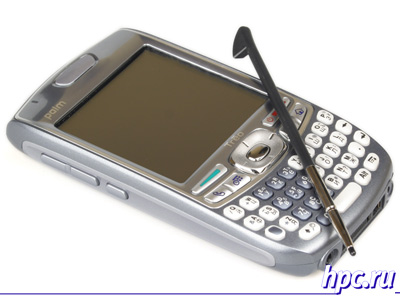 |
| Palm Treo 680 |
The most popular version of Palm OS - Garnet 5.4, this version is used in almost all modern PDAs and communicators Palm. The big plus is the excellent Palm OS address book and organizer, the likes of which no one has a single operating system, which is not surprising - because Palm was created as a portable database. A distinctive feature of all the devices based on Palm OS (except for Treo or TX) is separate from the screen area for drawing characters that are typed. Supports work with documents MS Office, and this function fairly well worked out even better than the Microsoft Windows Mobile. Finally, a negative feature of the Palm OS is the problem with switching encodings (KOI-8, Unicode, Win-1251) and part-time multitasking, for example, you can run the background listening to music (so the screen can be displayed only one application, however, that still need to user?). In the standard Palm OS contains the basic applications: Documents To Go for document Office (Word, Excel, Power Point), Calendar, Contacts, Calculator, File Manager, an Internet browser (designed based on the NetFront), Mailer (who knows everything underlying protocols and supports multiple mailboxes), Real One player, viewer videos and photos, various utilities. Palm is perfect as a reader electronic books, in conjunction with a mobile phone can access the Internet, will help manage the household appliances, acting as a remote control, replace the crib, you can quickly edit a document Word, when not near a computer, it could even measure the volume and distance. Surprising, because the owner of Palma is available just less than 30 thousand names of third party software.
Family of operating systems, Symbian
Symbian operating system today, quite successfully compete with the platform Windows Mobile. On the side of a big Symbian friendliness untrained technical users. Symbian operating system is divided into two groups: the first, developed by Nokia, called the Series 60 (as well as additional options - S80 and S90), the second - version for UIQ smartphones with touch screen and is used by SonyEricsson. The family of Series 60 - a platform based on Symbian OS and is designed for mobile phones. This platform was developed by Nokia and is used in its smartphones, as this platform is used Lenovo, LG, Samsung and Panasonic. Series 60 mobile platform is divided into editorial (Editions), depending on the version. Each edition may in turn have a set of add-ons (Feature Pack). The table below shows the different editions Series 60.
| Part I - The mobile operating system "width =" 176 "height =" 208 "/> |
| Here is the screen smartphone with Symbian Series 60 |
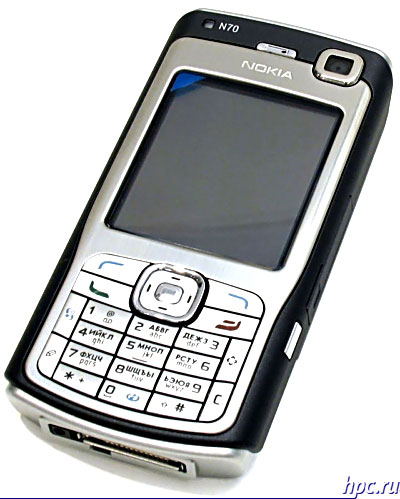 |
A distinctive feature of the Series 60 Platform is its multimedia focus and maximum functionality of the phone - you can not even think about the fact that the phone has an operating system. Already in the standard package are excellent editors for photographs and videos, provides not only the Real Player, but also the Flash Player for playing Flash-rollers (WM is being implemented in a third-party program). Additional software is written using a SDK (Software Development Kit) - a set of tools for software development (libraries, documentation, the emulator operating system for PCs), so has a very high stability and compatibility with the platform. All Programs for Series 60 are written using programming languages C + + and Java MIDP. To install the device software C + + files are packaged in SIS, written in Java - in a JAR file and JAD. Installation of SIS-applications for Series 60 3 Edition complicated system of signature programs (need to ensure greater stability). Symbian, however, still lacks the scalability and nadstraivaemostyu as Windows Mobile, making it the most stable platform. An added bonus of the S60 platform is a huge variety of games written specifically for her. This situation arose due to the well-known game smartphone, Nokia N-Gage, based on the Series 60. With all these features, the S60 has won great popularity among the majority of users opting for a smartphone. Series 80 Other Symbian this branch - the Series 80 platform is not much different from the S60, it is used on a limited number of devices - business communicators Nokia 9xxx series (9300, 9500).
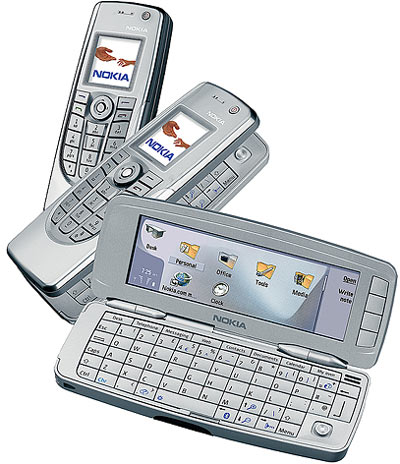 |
| Nokia 9300 Communicator |
A wide screen high resolution and some specific business functions (work with e-mail, for example), all management is carried out with the keyboard (two of them: QWERTY and numeric). Form-factor device - side flip, causing the device in the unfolded form resembles mikronoutbuk, and folded - hypertrophic phone. Series 90 - the main platform for touch-screen devices from Nokia - this is smartphone 7710.
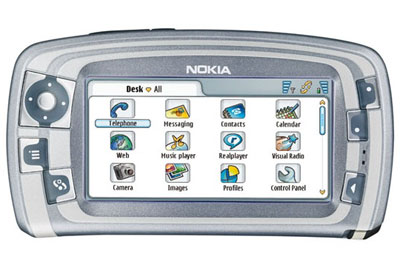 |
| Nokia 7710 |
The difference is slightly redesigned user interface and operating system support for touch screen (usually with a resolution of 640x200 pixels). S60 Touch - the newly announced platform. On this platform, there is little information, but we know that in the S60 Touch will be exercised control over the fingers (touch and movement of fingers across the screen) while maintaining control stylus.
| Part I - The mobile operating system "width =" 450 "height =" 253 "/> |
| Screenshot from the video that demonstrates the capabilities of the platform S60 Touch |
The original is the fact that according to some reports, S60 Touch will support the tactile feedback - that is, every action you'll not only see but feel. The family of Symbian UIQ. Generation operating systems UIQ (User Interface Quartz) is designed for smartphones with a touchscreen and differs from the S60 for the most part is a graphical environment. This platform is used on smartphones Sony Ericsson, the version currently in use - UIQ 3.0, which is based on Symbian 9.1. Feature of the construction vehicles P9xx series on this platform is the availability of flip - flip the keyboard, the closing of the screen while your device is a smartphone, because the touch pad screen is turned off. Opening the flip includes touch screen capabilities and the phone becomes a full smartphone with touch screen. Supports resolution of 320x240. Machines M and W series are not flip and look like ordinary communicators with a large screen.
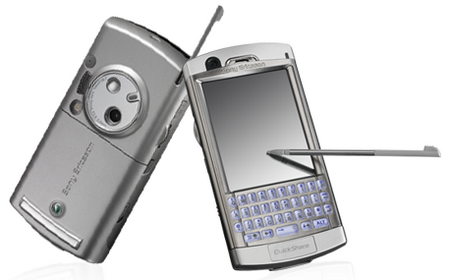 |
| Sony Ericsson P990i |
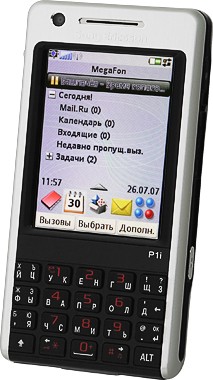 |
| Sony Ericsson P1i |
Feature of the UIQ 3.0 platform is a large set of software and applications installed on the smartphone manufacturer. In fact, here is everything you need for work.
- Browser Opera 8.0
- RSS-reader (internet news)
- image viewer (viewing and simple editing of photos)
- Sound Recorder (sound recording)
- Quick Office (P990i)
- PDF + (P990i reader PDF)
- Notes (notes)
- Tasks (Task Manager)
- Business Card Scanner (scanner cards, uses the built-in camera, but does not support the Russian language)
- Media Player (media player)
- E-mail Client (work email)
- MusicDJ (creation and editing of MIDI ringtones)
- Calendar (calendar-organizer)
- File Manager (working with files and programs)
- Calculator
- Unit Converter
- Timer
- Stopwatch
- World Clock
Although many of the necessary software installed, they will last only for the first time, and then still have to seek third-party software. And here are manifested major flaws Symbian UIQ, firstly, the small number of programs for this platform and they are mostly paid. Therefore UIQ is designed for those who are not on a particular desire to install applications on your phone - the standard software is made perfectly, but with the scalability problem. Secondly, the platform has stability problems, the new firmware, of course, the correct "wet", but before full stability is still far. Third, there are very weak customizable interface, you can just change the color and shape buttons. Although the possibility of changing the interface is reserved for mobile operators, which have been slow to take advantage of this opportunity. Fourth, SonyEricsson smartphones will only support memory cards Memory Stick, which is not so attractive in price as a competing format SD. In general, Sony is again on its own path.
Separately and original. Mac OS X and iPhone
On everyone's lips, many in the head. Probably many of you have or want to become a "victim" of aggressive marketing by buying today a cult device iPhone from Apple. Sales staff have started in America, July 29, 2007, and the iPhone was tied to one of the cellular operators in the U.S., making it impossible for the phone to other countries. Today, this binding is not due to various tricks, unlock the device. IPhone is based on a special version of Mac OS X, while the interface is adapted for use with your fingers. This innovation was the main "trick" the phone.
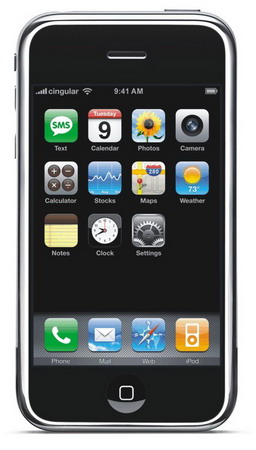 |
| iPhone |
Feature of the device is a large touch screen, which occupies almost the entire front panel and only one key, all management is done by touch and move your finger across the screen which makes it a smartphone, as it were alive. Today, programs for the smartphone from Apple is almost there, and the Platform SDK has not yet made public, so third-party programs can not be expected. Although, of course, the potential of the device is very high. The smartphone is based on the ARM processor, 620 MHz, screen resolution of 480x320, supported GSM850/900/1800/1900, Wi-Fi, Bluetooth 2.0 + EDR, EDGE, 2MP camera, Li-Ion Battery 8:00 razgovora/250 hours of standby, sizes 115h61h11, 5 mm, weight - 135 g. Standard functionality includes basic phone features.
- Calls, conference calls, no voice control, the main feature - visual voicemail, which works with U.S. carriers, you can manage voice mail messages directly into the phone interface.
- SMS is implemented in the form of dialogue.
- Ring tones are sold in the iTunes Store, in the normal ringing is not provided, but will work when using third-party software.
- Multimedia player like that in the iPod, but is able to much more, and large screen allows you to watch movies with high quality.
- Internet is possible thanks to EDGE and Wi-Fi, as well as built-in browser Safari. There is no technology Flash, however, is the fastest browser among all mobile devices.
- Operating System Mac OS offers in the future possibilities of easy porting of programs designed for the Macintosh on the iPhone. Perhaps then we will get one of the most successful communicators, but so far it's only plans for the future.
Some lesser-known operating systems
Besides the already described by us today, operating systems for mobile assistants, there are lesser-known operating system, for example, Linux or Blackberry. Linux - used PDA from Sharp. This model of Zaurus, little known here in Russia. Of course, this is not a full Linux. Yes, I use the kernel Linux, but here's a shell is quite another and to the compatibility with the "big» Linux it away.
 |
| Sharp Zaurus SL-C3100 |
Sharp used the shell is called Qtopia. The second feature of the operating system from Sharp is the simplicity of the interface and work (unlike the desktop version of Linux), so do not be an expert to learn the "Zavriev. In general, the platform is very popular in Asia, in Russia we spread a little, because of little interest, except for tehnomanyakov who are not averse to play around with different techniques, explore new possibilities. Blackberry - Smartphone series, produced by Canadian company RIM (Research in Motion). The company was able to offer its original concept of mobile devices that have become popular overseas. Blackberry is a platform for wireless communications in cellular networks, which allows instant access to the Internet, e-mail (including a secure protocol Push Mail) and other communications.
| Part I - The mobile operating system "title =" Smart handheld assistants. Part I - The mobile operating system "width =" 344 "height =" 502 "/> |
| RIM Blackberry 8820 |
Classic Blackberry endowed convenient QWERTY-keyboard and perfectly suitable for mobile operation interface. This is the main components of success of these smart phones, especially among corporate users. As for Russia, while only the MTS and Beeline signed an agreement with the RIM Blackberry platform to implement in our country as a whole, these smartphones we have practically never occur.
Conclusion
In conclusion, we note that this article spoke only on the tip of the iceberg, because the review of each operating system can take an entire book, here represented the quintessence of opening the veil of secrecy on newcomers, thinking about moving to a smart car. In the next article we will consider in detail the various PDAs, smart phones, communicators and navigators, their differences, form factors and features. In the meantime, let's sum up today's paper. Of course, choose your device to you, we just try to help. Below is a table with the main features of each OS.
The authors, translation:












